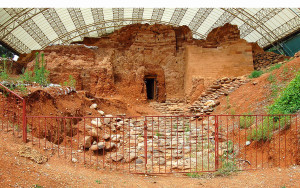In about 1,800 B.C., the Canaanites established a major city called Laish in the region around Tel Dan. Archaeologists have uncovered a mud brick city gate from that period that includes the oldest known arched opening, an invention once incorrectly attributed to the much later Romans. According to the Book of Joshua, members of the Tribe of Dan conquered Laish after their exodus from Egypt because the Philistines prevented them from capturing the land near the Mediterranean coast originally assigned to them. Archaeologists have unearthed stone gates and walls from the period of Israelite occupation of Dan, which the Bible says formed the northern boundary of the United Monarchy established by King David. Visitors can also explore the excavated “high place” the Bible says Jeroboam built in Dan when the northern Kingdom of Israel split from the southern Kingdom of Judah after the death of David’s son Solomon. Dan’s high place, featuring a golden calf, competed for worshippers with the Temple in Jerusalem.
During excavations at Tel Dan in 1994, archaeologist Avraham Biran discovered pieces of a broken stele (monument) erected by King Hazael of Aram-Damascus in the late ninth century B.C., boasting of capturing Dan and killing Israel’s King Jehoram. Most scholars now believe the Aramaic writing on the stele also says Hazael killed Ahaziah, “son of the king of the House of David,” the first non-Biblical evidence of David’s existence.
Although the now famous Tel Dan stele confirms the historicity of David and his dynasty, it contradicts the Biblical account of the Israelites’ battle with Hazael. According to the Book of Second Kings, Jehoram and Ahaziah were killed in a coup after the battle by their general Jehu, who then became king. Even details in battle reports can reflect their author’s point of view.
